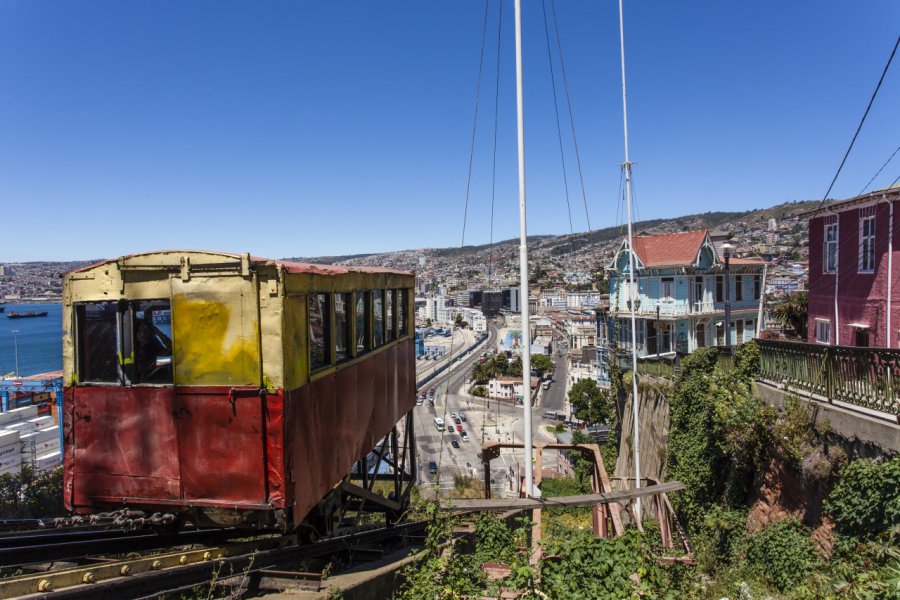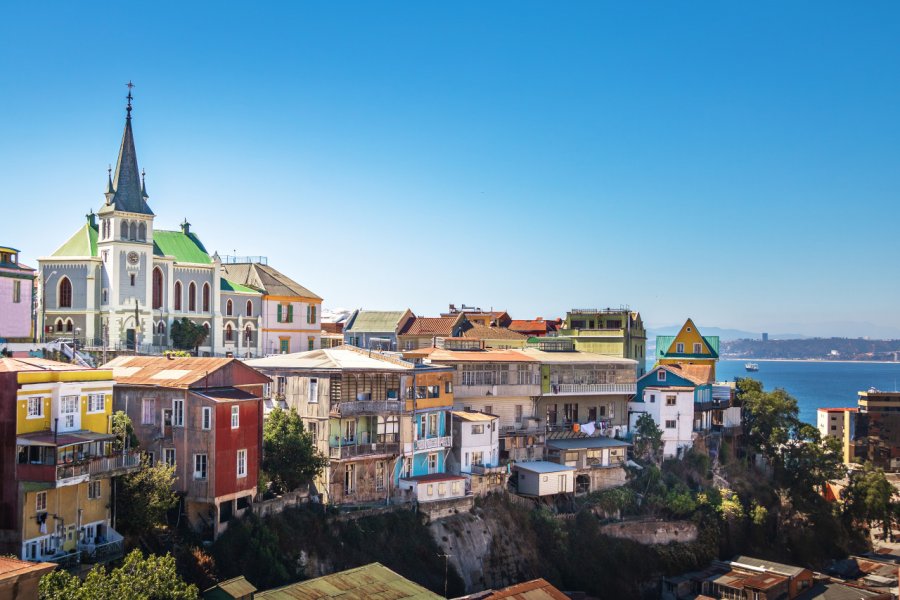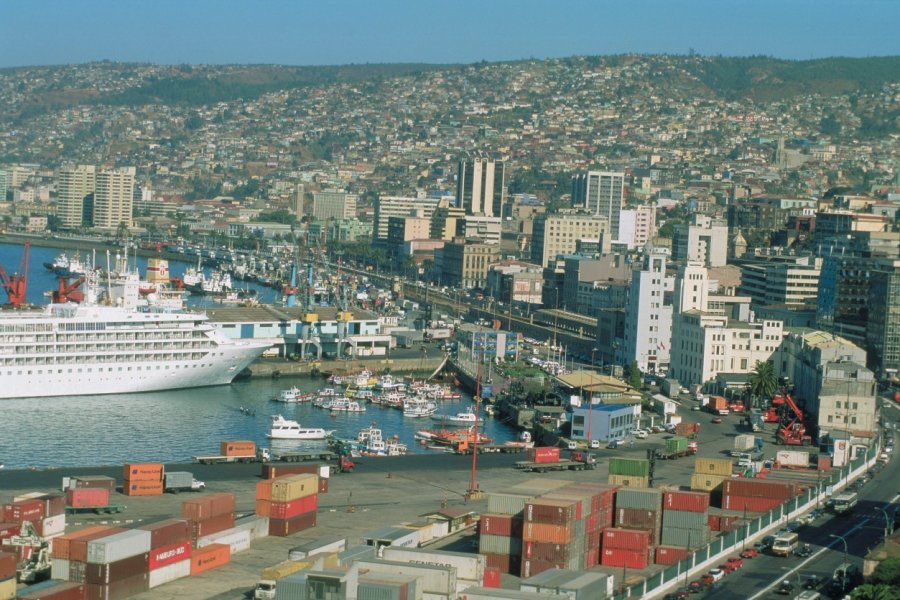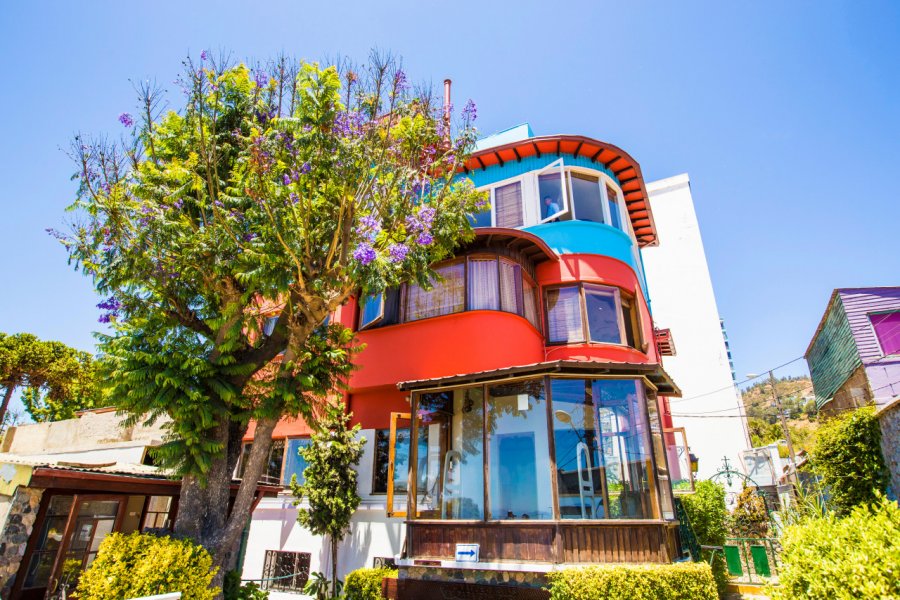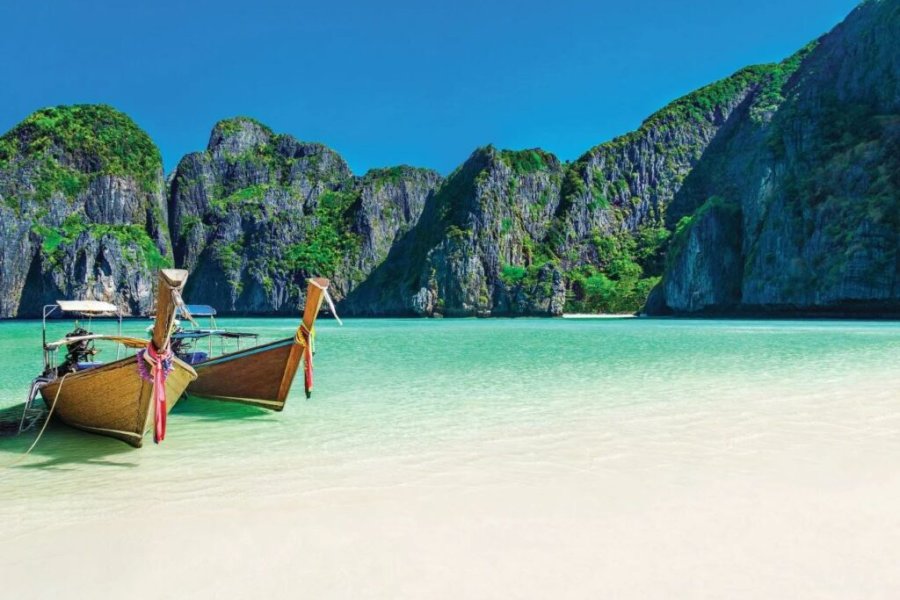Travel Guide Valparaíso
Find an accommodation
Advertising
Although an irreducible economic decline over the last century has somewhat tarnished its image, the "Pearl of the Pacific" has retained its charm as a mysterious port city. It's very simple: Valparaiso leaves no one indifferent, you either love it or hate it! It is a port whose walls sweat history, that of the earthquakes by their cracks or by their entanglement, that of the sailors and the girls of joy in brothels where the vagabonds and the bohemians gather, that of an intellectual vigour never denied. Its labyrinth of alleys, its rattling elevators, the perspectives and angles that change with every step, the incessant aesthetic battle between nature and the city - the rough rock against the building, the tree whose roots encroach on the stairs, the wild hills that taunt the ships - all this atmosphere has inspired poets, painters, writers. Some find it dirty and uninteresting, others stay for weeks, months, even years. An absolute myth of the universal seafarer, it has welcomed the new century with a rather radical urban development plan, which aims to bring the inhabitants closer to the ocean (a mega-project currently underway in the Muelle Barón) and modernize the architecture. But if everything can change soon, the essential remains: Valparaíso is to Santiago what Marseille is to Paris: rebellious, boisterous, picaresque, filthy, infinitely beautiful and above all more human. Since 2003, the historic center is part of the cultural heritage of humanity, protected by UNESCO. According to the 2012 census, the city had 292,000 inhabitants.HistoryBefore the arrival of the Spaniards, the Bay of Quintil was inhabited by the Changos who were subject to Tanjalonco, the Lord of Quillota. Juan de Saavedra, who came to supply Diego de Almagro, discovered it in May 1536 and named it after his native town. In 1541, Pedro de Valdivia made it a port to supply Santiago. However, the city did not receive a foundation act and grew spontaneously, according to the needs of maritime trade. It was not until 1560 that the outline of a real city finally took shape. Regularly attacked from that time onwards by English and Dutch privateers (Francis Drake and Joris Spilbergen in particular), the port was surrounded by many legends of treasures hidden in the mountains and epic naval battles in the bay. A military regiment and several fortresses were set up in the 17th century to prevent such attacks.From the second half of the 18th century, the port experienced a revival of activity: wine, salted meat, leather and cheese were sent to Peru. But if trade was intense in summer, the port was closed in winter because of the bad weather. In 1730, there were no more than 100 houses and 4 churches.During the Spanish reign, the development of Valparaíso was slowed down because of the predominance of Lima and the commercial monopoly imposed by Spain; Chile could only trade with the other colonies of the continent and not directly with Spain or the rest of Europe. It was Lima, the seat of the viceroyalty, that made the most profit. In addition, the king had forbidden the routes to Buenos Aires and the Strait of Magellan for fear of attacks by English piracy.After independence, the Chilean ports opened to free trade, and Valparaíso was declared a "free port" in 1822. Ideally placed to receive the ships that rounded Cape Horn and came to trade with the islands and ports of the Pacific, the port served as the main supply base for these ships. After their perilous journeys, they entered its bay as if in paradise. Thus, in a quarter of a century, the population of the city more than tripled, going from about 7,000 inhabitants in 1810 to 24,316 in 1835, the year of the first census in Chile. In 1841, Valparaíso reached the figure of 50,000 inhabitants (then 121,600 in 1895 and 162,000 in 1905, including 12,000 foreigners). Many European immigrants (English, German and French) came to settle in order to control the trade of local products. The Calcuta shipping company was created in August 1819, to trade with India and China. Banks were established and provided the financial resources necessary for the exploitation of Chile's natural resources: the pioneers of the copper, silver and saltpeter mines came here to obtain the money necessary for their dreams. Valparaíso was the birthplace of Chile's first stock exchange, the first tramways, the first electric lighting system, the first telephones and the first Castilian-language newspaper, El Mercurio de Valparaíso, in 1827. The mining bourgeoisie also settled here and built beautiful houses, some of which have survived earthquakes.At the time of the gold rush, Valparaíso, an almost obligatory stopover for the ships of gold seekers, was invaded by the frenzy that the precious metal aroused. Thus, in the summer of 1849, more than 170 ships of all nationalities anchored in its port. It was then the main financial, commercial and artistic city of the country.But this flamboyant era was shaken by a terrible earthquake in 1906 and by the opening of the Panama Canal in 1914. And then the decline of Valparaíso began, irreparable, between the two wars. In addition to the new maritime routes, the Chilean economy was reorganized. The policies developing internal industrialization, trade and capital migrated to Santiago, the heart of the decision-making process. The port gradually fell into a kind of lethargy that new port services or specialized industries could not hide, as did the construction of a new Parliament in 1990, because the deputies never really wanted to get used to the idea of having to leave the capital for this "lost hole".The city todayThis "beautiful and extravagant city, a perfect curve on the blue sea, the crumbling of its dishevelled hills encircling the bay like an echo, a reflection in the mirror of the earth of the waves of the Pacific on stormy days" (Alain Jaubert), this port of a thousand colours, is the setting of a theatre where the boundaries between actors and spectators are abolished. One of the characters in this timeless fairy tale is, of course, the night and its lights, those of the boats, those of the lighthouse launching its red and white calls to the marine darkness, those of the lighted houses riddling the cerros (mountains) and glittering so strongly that they give the impression of wanting to rival the lighthouse and take its place in the hearts of nostalgic sailors. These lights seem to originate in the sea and are like the extension of a wave that, little by little, submerges the city.Valparaíso is an architect's paradise. As Jaubert points out: "There are more ideas in these popular buildings than in all the American and European architects combined. ...] In the working-class neighborhoods, there are houses built from the remains of old shipwrecks. It is said that there were once hundreds of them, enough to provide them with material. ...] They remind me of ships. Ships stuck in the earth of the hills, captured, and which would remain there, boiling with impatience, ready to return to the water. And facing the ocean, facing the winds, the rain, the spray. Remember the cabin in The Gold Rush. It sways, it leans, it risks falling into the abyss. Here, all the houses expect to slide into the ravine at any moment. They move. They are alive. They live in the uncertainty of tomorrow. They fall and renew themselves. It is a city that moves. It is an unpredictable city.In recent years, numerous restaurants, a host of shops, craft and fashion boutiques, and new tourist prospects have profoundly changed the urban landscape of Valparaíso. There is no shortage of projects, completed or yet to be implemented, such as the project for a public square on the seafront with shops, restaurants and so on... The baroque and unusual magic of the city could well disappear in modernity, order and harmony. Because the charm of Valparaíso, "a cluster of crazy houses" according to Neruda, is perhaps this disparate and disorderly agglutination, this fusion of the beautiful and the ugly, this perpetual mise en abîme of the senses. Isn't this the message delivered by the great Chilean poet when he wrote: "Valparaíso usurped me, subjected me to its domination, to its brilliance" ?To get a feel for the "strangeness" of the mythical port of Valparaíso before your departure, we recommend reading Alain Jaubert's novel, Val Paradis, published by Gallimard in 2004. It is the story of a sailor on a stopover in Valparaíso, who recalls memories and anecdotes, the framework of the story being constituted by his very agitated night in Valparaíso during the 1950s.
What to visit Valparaíso?
Advertising
Suggested addresses Valparaíso
Weather at the moment
Advertising
Organize your trip with our partners Valparaíso
Transportation
Book your plane tickets
Car Rental
Boat rental
Accommodation & stays
Find a hotel
Holiday rental
Find your campsite
Tailor-made trip
Immersion travel
Services / On site
Activities & visits
Find a doctor




